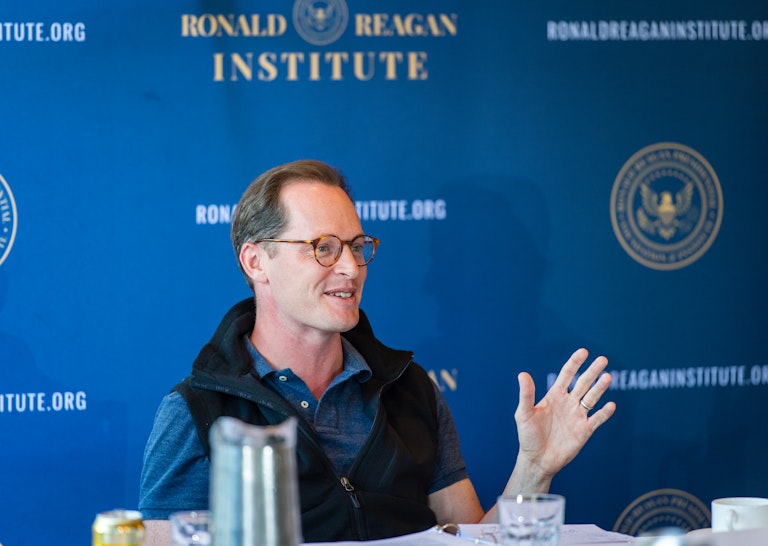Ronald Reagan Institute
Defense Strategy and Priorities: Topline or Transformation?

By Roger I. Zakheim

A Response from Roger Zakheim
We have made a tremendous amount of progress in defense policy over the past two years. The release of the National Defense Strategy (NDS), with its emphasis on China, and robust defense budgets to support its execution serve as the two most notable metrics of this progress. Neither of these developments was inevitable. Yet, relative to the challenge of executing and resourcing the strategy, the progress to date pales in comparison to the challenges ahead. That challenge requires something that’s difficult for any large organization: the Pentagon needs to walk and chew gum at the same time. It needs to figure out how to keep the peace today—that is to deter high-end and low-end adversaries—and to change (dare I say “transform”) the force for a new generation of warfare.
For a variety of reasons, defense intellectuals, elected officials, and policymakers are embracing the need to transform. What’s unclear and requires more attention is the pace and nature of that transformation. That’s the debate before us. Can we transform iteratively, must it be done radically, or, as the pessimists predict, can it happen only once we find ourselves in a hot fight with our forces on their heels?
My own view departs from what is implicit in Chris Brose’s excellent paper—that we must radically transform. This is not to say I disagree with the thrust of Chris’s arguments. The opposite is true: My recent experience on the National Defense Strategy Commission reinforces many of Chris’s concerns. Most notably, I saw little evidence that the Department of Defense has a conceptional framework to leverage new technologies in an armed conflict. The department lacks a focused, tangible set of new concepts for how we might fight China; this was perhaps the most telling sign that we’re at risk of entering a future fight with the force of today.
“Yet, to transform without a clear vision of what we’re transforming into risks not only failing in a future fight but also forfeiting today’s military strength.”
Yet, to transform without a clear vision of what we’re transforming into risks not only failing in a future fight but also forfeiting today’s military strength. Here’s an example of what I mean: Making the operational leap into a force that leverages autonomy, artificial intelligence, and machine learning may very well mean that we no longer need manned fighter aircraft.
So, when do we jettison the fighters? Can we make such a transition while simultaneously investing in fifth- and sixth-generation fighters and maintaining a military service and an industrial base that are committed to fighters? How do we “disrupt” the fighter community? While I support increasing funds for our military, do we have resources to cover both disruptive autonomy and legacy fighter programs? And should we? As Chris points out, why invest in more fighters if prevailing in a future fight won’t be determined by manned fighters? Or worse, investing in fighters could play into the very cost-imposing strategy the Chinese are pursuing against us. These are alluring questions that our leaders would do well to ponder. I’m all for investing in an operational concept of swarming autonomous aircraft if it existed beyond a PowerPoint® slide. Unfortunately, my own investigation into this question revealed that even a PowerPoint® is hard to come by; thus, until the military has more to show for it, I wouldn’t trade the F-35 of today, for example, for an inchoate concept of tomorrow.
This, of course, leads to the challenge of how to catalyze change in the fixed structures of the Pentagon. How long do we wait when we’re dealing with a bureaucracy that is institutionally built to preserve the status quo? This is where I depart slightly from Mackenzie Eaglen’s argument. Even with all of the well-reasoned justifications for today’s defense program, there’s little hope it will yield what’s needed for tomorrow.
Yes, our plate today is full. We need a global force presence. We need to restore the readiness of today’s force and modernize the nuclear triad. But even with all the needs of today, we must begin driving decisions over the next five-year period that result in a material change in the force structure and force presence we employ today. And this leads to the how: This change should be radical in its management but not in its implementation. Let’s not jettison a single carrier until we have something to replace it with. Too much is at stake today. The transformation needs persistent attention with clear benchmarks and milestones attached to its implementation. We need to maniacally press the Department of Defense to transition from experimenting and piloting into programs of record that truly displace the old way of fighting. If we are truly on the precipice of introducing monumental changes equivalent to the tank replacing the horse cavalry, then the future years defense program needs to more aggressively push for these changes, and it should be measured against this transformation. This, of course, is happening unevenly, if at all.
Part of this change requires new approaches to lesser challenges too. I mean that we need to change the way we compete today, with the way we deploy and deter in the Middle East being first on the list. We ought to deter Iran, for example, with lower-end and less conventional capabilities, so we can free up the higher-end platforms for the Chinas of the world. This, of course, was the direction of the NDS, yet we see little evidence of its implementation. Take the recent tensions in the Strait of Hormuz. The Trump administration employed the same costly playbook the military has used for the past 30 years by deploying a carrier to the region and increasing the U.S. force presence. How we deal with low-end threats today affects our ability to deal with bigger threats tomorrow.
I would like to make a final point regarding how this debate risks being exploited by the perennial critics of the Pentagon strategy and budget. This transformation, whether it be implemented iteratively or radically, will not be done by reducing our role in the world, nor can it be done by spending less on the military. Just read the latest issue of the New York Review of Books, and you encounter the specious arguments that draw in fiscal conservatives and liberals alike. So the argument goes: Eisenhower’s military industrial complex invents the threats that beholden lawmakers are only too willing to believe and resource when, of course, the only real threat is the wasteful bureaucracy that—if it were more responsible (and peaceful)—could preserve the peace for pennies on the dollar. If only it were so easy.
"The Future of Conservative Internationalism," which is a collection of essays from the Reagan Institute Strategy Group, convened in Beaver Creek, Colorado, in July 2019.
Join Our Newsletter
Never miss an update.
Get the latest news, events, publications, and more from the Reagan Institute delivered right to your inbox.
